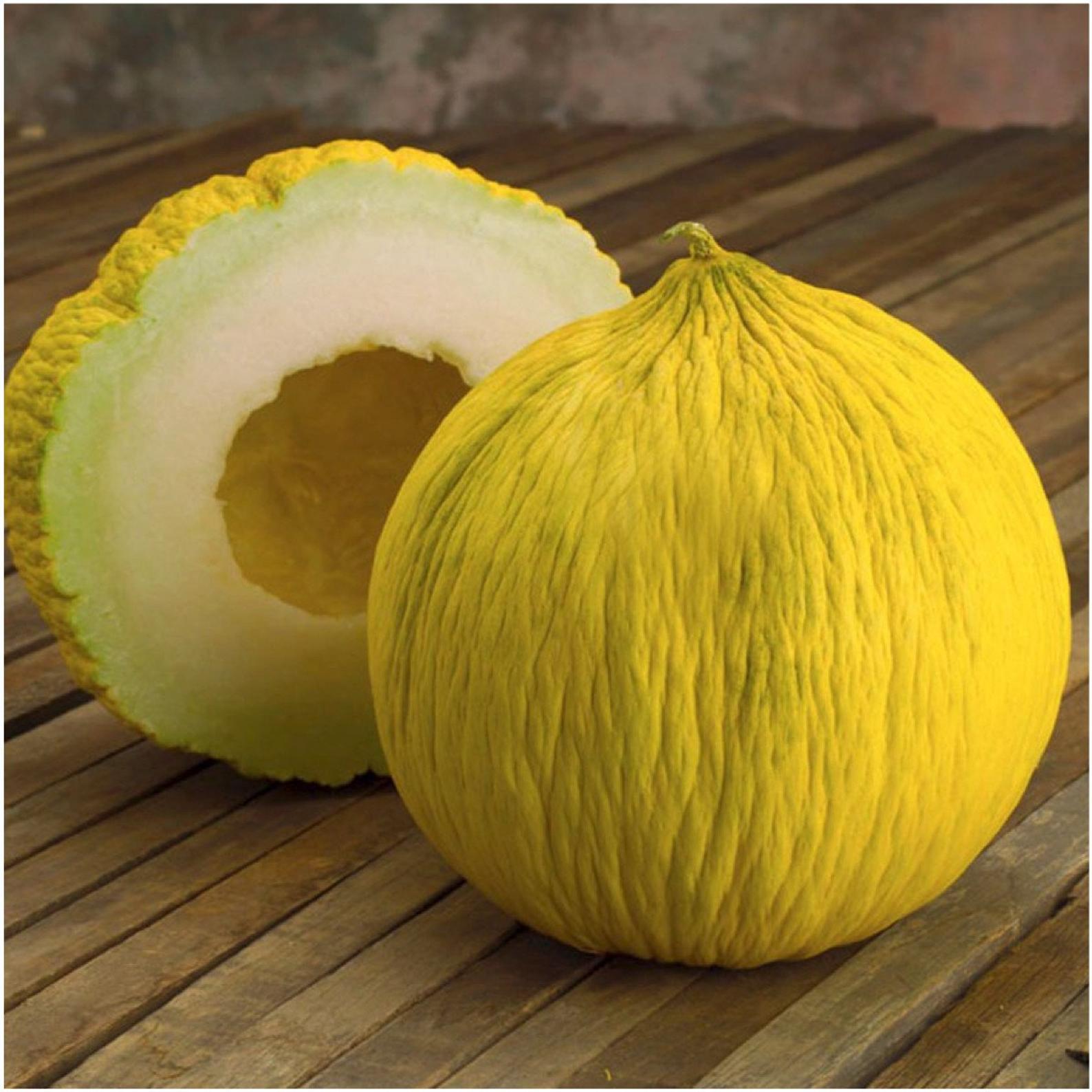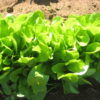Description
Golden Beauty Casaba Melon (A.K.A. Casaba Fruit, Casaba Golden Beauty)
25 Seeds per pack
Days to Maturity 105–115 Days
Sun Requirements: Full Sun
Botanical Name: (Cucumis melo)
Golden Beauty Casaba Melon was developed in the U.S. in the 1920s and quickly gained popularity in American gardens. Originally from near Kasaba, Turkey, this heirloom is known for its sweet, musky aroma, long shelf life, and distinctive appearance.
Spreading 10′ vines yield large, oval fruits weighing 6–8 pounds and measuring about 6″ across. Golden, crinkled skin encases white, juicy flesh with a sweet, musky aroma. These melons do not slip from the vine, making harvest timing flexible—pick when mature and allow to soften slightly at the blossom end in storage. While well-suited to gardens across the U.S., it performs especially well in hot, dry climates such as those found in Southern California, New Mexico, and West Texas. It thrives in sandy loam with good fertility.
Enjoy its fragrant, juicy flesh sliced fresh, added to fruit salads, or blended into refreshing summer drinks. The tough rind makes it excellent for storing and shipping, allowing enjoyment well into the winter.
Rich in vitamins A and C, it’s a refreshing and nutritious addition to the late-summer garden!
Planting Instructions for Casaba Golden Beauty Cantaloupe Seeds
When to Plant:
Direct sow Cabsa Golden Beauty Cantaloupe seeds outdoors 1 to 2 weeks after your last frost date, once the soil consistently reaches 70°F (21°C) or warmer. For shorter seasons or cooler regions, start seeds indoors 4 to 6 weeks before last frost, using peat pots or soil blocks to avoid root disturbance. Transplant outdoors after hardening off and when both soil and air temperatures are consistently warm and the danger of frost is past.
Where to Plant:
Choose a site in full sun that receives at least 8 hours of direct sunlight daily. Because this is a long-season variety, choose the sunniest, warmest spot available to ensure full ripening before fall. Cabsa Golden Beauty Cantaloupes thrive in fertile, well-drained soil with a pH of 6.0–7.0. Raised beds or south-facing slopes are ideal. Incorporate 2–3 inches of compost before planting. Avoid planting in areas that recently grew other melons, cucumbers, squash, or pumpkins.
How to Sow:
Sow seeds ½” to 1″ deep. If planting in rows, space seeds or transplants 18–36″ apart in rows 5–6′ apart. For hills, sow 3–4 seeds per hill and thin to the strongest 1–2 plants. For trellising, space plants 12–18″ apart along a sturdy support.
Watering:
Keep soil consistently moist through germination. Once vines are established, provide 1–2 inches of water per week. Water deeply and less frequently to encourage deep rooting. Reduce watering slightly once fruit begins to ripen to improve sweetness and avoid splitting. Avoid overhead watering to reduce the risk of mildew.
Fertilization:
Mix compost into the planting site before sowing. Additional fertilizer is typically not needed unless soil is poor. If desired, side-dress with compost tea, fish emulsion, or a balanced organic fertilizer once vines begin to spread and again when the first small fruits begin to form.
Mulching:
Once your seedlings are growing well, add mulch around the plants. Use black plastic if your goal is to warm the soil. Warmer soil helps seeds sprout faster and encourages early root and vine growth, which is especially helpful in cooler climates or early in the season. If you’re mainly trying to hold in moisture and stop weeds, straw or shredded leaves are good options, but they won’t help the soil warm up as much. Mulching also keeps the fruits clean by lifting them off the dirt and helps stop mud from splashing onto them when it rains.
Training & Pruning:
Vines can be allowed to sprawl or trained vertically. For vertical growth, support fruit with cloth slings. If desired, lightly prune some of the small side branches that grow off the main vine to help air move through the plant and let it focus energy on growing better-quality fruits. Avoid over-pruning, which can reduce flower production and sugar development.
Pollination:
Cabsa Golden Beauty Cantaloupes produce both male and female flowers. Bees and other pollinators are essential for fruit set. Encourage pollination by planting pollinator-friendly flowers and herbs nearby. Good choices include borage, dill, sunflowers, marigolds, and oregano allowed to flower. These help attract bees and other insects that will visit your Cabsa Golden Beauty Cantaloupe blooms. In low-pollinator areas, hand pollinate by transferring pollen from male to female blooms using a small paintbrush.
Common Pests & Diseases:
- Pests: Watch for aphids, cucumber beetles (vector for bacterial wilt), squash bugs, and vine borers. Use row covers until flowering, hand-pick pests, or apply insecticidal soap in the early morning or evening.
- Diseases: Powdery mildew, downy mildew, and leaf blights can occur. Improve air circulation, avoid overhead watering, and space plants adequately. Treat outbreaks with organic fungicides or DIY sprays (e.g., baking soda solution).
Harvesting:
Cabsa Golden Beauty Cantaloupes are ready to harvest when the rind turns a rich, golden yellow and develops a deeply wrinkled texture. This variety does not develop the netting typical of other cantaloupes and usually does not slip from the vine on its own. Instead, look for a sweet, fragrant aroma near the blossom end (opposite the stem), and gently press that end—it should give slightly when ripe. Cut the fruit from the vine carefully, as it won’t detach naturally. If picked too early, the fruit may lack full sweetness and aroma.okay is there anything else that should be changed? its a longer seasoncantaloupe (
Storage:
Store ripe, uncut Cabsa Golden Beauty Cantaloupes at 45–50°F for up to 1 week. Once cut, refrigerate and use within 3 days. Wash melons thoroughly before cutting to avoid transferring bacteria from rind to flesh.
Seed Saving:
Saving Cabsa Golden Beauty Cantaloupe seeds is an enjoyable and economical way to preserve this unique heirloom variety. Cabsa Golden Beauty Cantaloupes are insect-pollinated and cross readily with other melon types, so avoid growing multiple melon varieties within ½ mile of one another.
Let the melons ripen fully on the vine. Once picked, cut them open the long way and scoop out the seeds into a jar. Add room temperature (not hot) water and let the mixture sit for 2 to 4 days, stirring it once each day to help the seeds separate. Good seeds will sink, while pulp and non-viable seeds float. Pour off the debris, rinse the good seeds thoroughly, and spread them out on a paper towel or mesh screen to dry for several days in a well-ventilated area.
Once your seeds are fully dry, you can store them in a labeled container. For longer storage, you can keep the container right in the freezer. Freezing helps protect seeds from moisture, pests, and temperature swings, especially over many months. For a quick and easy option, use our seed-saving envelopes. They’re simple to use, pre-labeled, and include spaces to write the variety, date, and any notes you want to remember. They help keep your seeds neat, labeled, and easy to find when you’re ready to plant next season. When stored properly, Cabsa Golden Beauty Cantaloupe seeds can last 3–5 years.
FAQ:
What is the historical or notable background of Golden Beauty Casaba Melon?
Golden Beauty Casaba Melon originated in the U.S. during the 1920s and was bred from Turkish melons near Kasaba. It quickly became a beloved heirloom for its sweet aroma, large fruits, and excellent keeping qualities.
How would you describe the flavor of Golden Beauty Casaba Melon?
The flesh of Golden Beauty Casaba Melon is white, juicy, and sweet with a distinct musky aroma, offering a delicious and fragrant flavor.
What does Golden Beauty Casaba Melon look like, and what are its growing habits?
Golden Beauty Casaba grows on vigorous 10′ vines, producing large, oval melons weighing 6–8 pounds. The fruits are golden with deeply wrinkled skin and do not "slip" from the vine, allowing flexible harvest timing.
How and when do I harvest Golden Beauty Casaba Melon?
Harvest when the rind turns golden and the blossom end becomes slightly soft with a strong musky scent. Since it won’t slip from the vine, cut it carefully to avoid damaging the plant.
When is the best time to plant Golden Beauty Casaba Melon?
Plant after the last frost when soil reaches 70°F or warmer. In cooler regions, start indoors 4–6 weeks early and transplant after danger of frost has past.
What are the common culinary uses for Golden Beauty Casaba Melon?
Golden Beauty is perfect sliced fresh, added to fruit salads, or blended into refreshing drinks.
What’s the best way to store Golden Beauty Casaba Melon after harvest?
Store whole, ripe melons at 45–50°F for up to a week. Once cut, refrigerate and consume within 3 days. Its firm rind helps it keep well, for shipping making if great for farmers markets.
What nutrients does Golden Beauty Casaba Melon provide?
This melon is rich in vitamins A and C, making it a nutritious option for late-summer refreshment and immune support.
9. Does Golden Beauty Casaba Melon have any notable disease resistance or climate adaptability?
While not specifically bred for disease resistance, Golden Beauty Casaba Melon is naturally well-adapted to hot, dry climates like Southern California, New Mexico, and West Texas.


















Reviews
There are no reviews yet